Getting Started with Excel 2010
This chapter teaches you how to start an excel 2010 application in simple steps. Assuming you have Microsoft Office 2010 installed in your PC, start the excel application following the below-mentioned steps in your PC.
Step 1 − Click on the Start button.
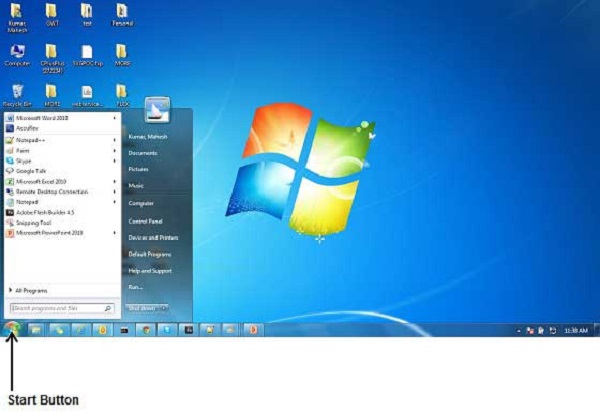
Step 2 − Click on All Programs option from the menu.
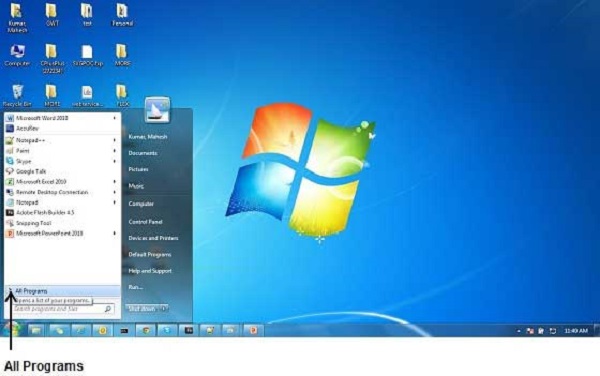
Step 3 − Search for Microsoft Office from the sub menu and click it.
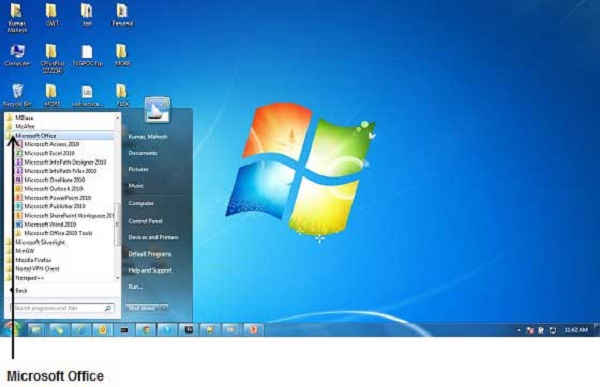
Step 4 − Search for Microsoft Excel 2010 from the submenu and click it.
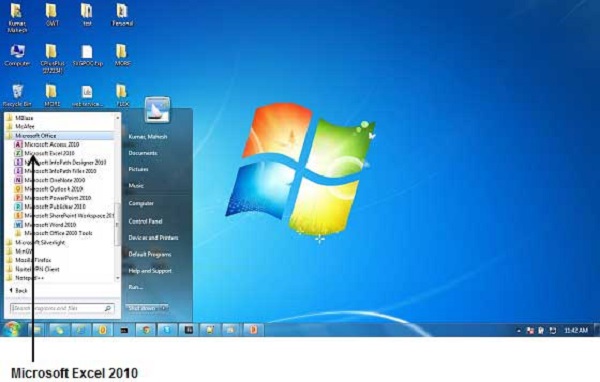
This will launch the Microsoft Excel 2010 application and you will see the following excel window.
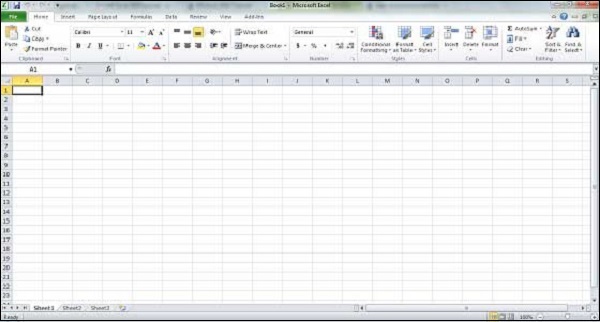
Explore Window in Excel 2010
The following basic window appears when you start the excel application. Let us now understand the various important parts of this window.
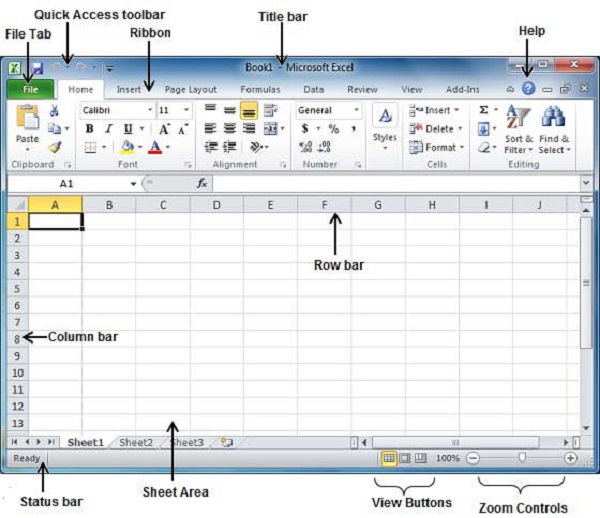
File Tab
The File tab replaces the Office button from Excel 2007. You can click it to check the Backstage view, where you come when you need to open or save files, create new sheets, print a sheet, and do other file-related operations.
Quick Access Toolbar
You will find this toolbar just above the File tab and its purpose is to provide a convenient resting place for the Excel's most frequently used commands. You can customize this toolbar based on your comfort.
Ribbon

Ribbon contains commands organized in three components −
- Tabs − They appear across the top of the Ribbon and contain groups of related commands. Home, Insert, Page Layout are the examples of ribbon tabs.
- Groups − They organize related commands; each group name appears below the group on the Ribbon. For example, group of commands related to fonts or group of commands related to alignment etc.
- Commands − Commands appear within each group as mentioned above.
Title Bar
This lies in the middle and at the top of the window. Title bar shows the program and the sheet titles.
Help
The Help Icon can be used to get excel related help anytime you like. This provides nice tutorial on various subjects related to excel.
Zoom Control
Zoom control lets you zoom in for a closer look at your text. The zoom control consists of a slider that you can slide left or right to zoom in or out. The + buttons can be clicked to increase or decrease the zoom factor.
View Buttons
The group of three buttons located to the left of the Zoom control, near the bottom of the screen, lets you switch among excel's various sheet views.
- Normal Layout view − This displays the page in normal view.
- Page Layout view − This displays pages exactly as they will appear when printed. This gives a full screen look of the document.
- Page Break view − This shows a preview of where pages will break when printed.
Sheet Area
The area where you enter data. The flashing vertical bar is called the insertion point and it represents the location where text will appear when you type.
Row Bar
Rows are numbered from 1 onwards and keeps on increasing as you keep entering data. Maximum limit is 1,048,576 rows.
Column Bar
Columns are numbered from A onwards and keeps on increasing as you keep entering data. After Z, it will start the series of AA, AB and so on. Maximum limit is 16,384 columns.
Status Bar
This displays the current status of the active cell in the worksheet. A cell can be in either of the fours states (a) Ready mode which indicates that the worksheet is ready to accept user inpu (b) Edit mode indicates that cell is editing mode, if it is not activated the you can activate editing mode by double-clicking on a cell (c) A cell enters into Enter mode when a user types data into a cell (d) Point mode triggers when a formula is being entered using a cell reference by mouse pointing or the arrow keys on the keyboard.
Dialog Box Launcher
This appears as a very small arrow in the lower-right corner of many groups on the Ribbon. Clicking this button opens a dialog box or task pane that provides more options about the group.
BackStage View in Excel 2010
The Backstage view has been introduced in Excel 2010 and acts as the central place for managing your sheets. The backstage view helps in creating new sheets, saving and opening sheets, printing and sharing sheets, and so on.
Getting to the Backstage View is easy. Just click the File tab located in the upper-left corner of the Excel Ribbon. If you already do not have any opened sheet then you will see a window listing down all the recently opened sheets as follows −
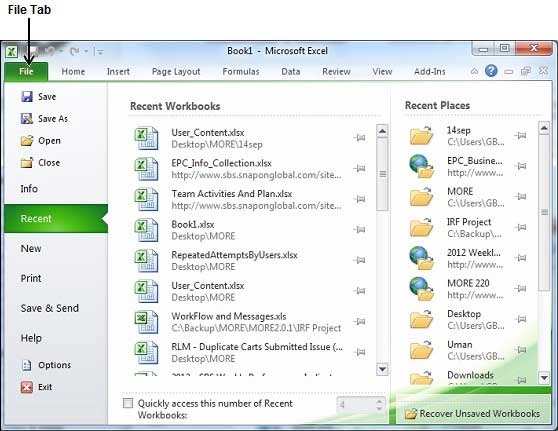
If you already have an opened sheet then it will display a window showing the details about the opened sheet as shown below. Backstage view shows three columns when you select most of the available options in the first column.
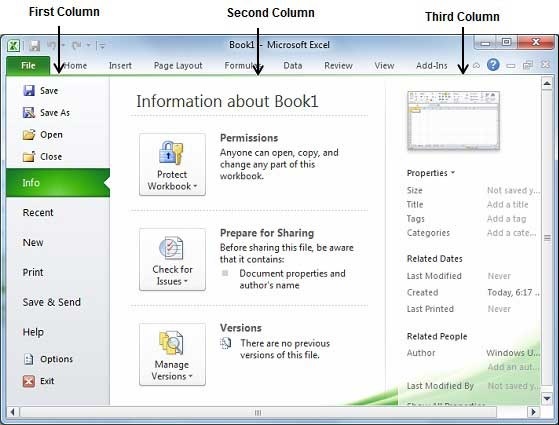
First column of the backstage view will have the following options −
| S.No. | Option & Description |
|---|---|
| 1 |
Save
If an existing sheet is opened, it would be saved as is, otherwise it will display a dialogue box asking for the sheet name.
|
| 2 |
Save As
A dialogue box will be displayed asking for sheet name and sheet type. By default, it will save in sheet 2010 format with extension .xlsx.
|
| 3 |
Open
This option is used to open an existing excel sheet.
|
| 4 |
Close
This option is used to close an opened sheet.
|
| 5 |
Info
This option displays the information about the opened sheet.
|
| 6 |
Recent
This option lists down all the recently opened sheets.
|
| 7 |
New
This option is used to open a new sheet.
|
| 8 |
Print
This option is used to print an opened sheet.
|
| 9 |
Save & Send
This option saves an opened sheet and displays options to send the sheet using email etc.
|
| 10 |
Help
You can use this option to get the required help about excel 2010.
|
| 11 |
Options
Use this option to set various option related to excel 2010.
|
| 12 |
Exit
Use this option to close the sheet and exit.
|
Sheet Information
When you click Info option available in the first column, it displays the following information in the second column of the backstage view −
- Compatibility Mode − If the sheet is not a native excel 2007/2010 sheet, a Convert button appears here, enabling you to easily update its format. Otherwise, this category does not appear.
- Permissions − You can use this option to protect the excel sheet. You can set a password so that nobody can open your sheet, or you can lock the sheet so that nobody can edit your sheet.
- Prepare for Sharing − This section highlights important information you should know about your sheet before you send it to others, such as a record of the edits you made as you developed the sheet.
- Versions − If the sheet has been saved several times, you may be able to access previous versions of it from this section.
Sheet Properties
When you click Info option available in the first column, it displays various properties in the third column of the backstage view. These properties include sheet size, title, tags, categories etc.
You can also edit various properties. Just try to click on the property value and if property is editable, then it will display a text box where you can add your text like title, tags, comments, Author.
Exit Backstage View
It is simple to exit from the Backstage View. Either click on the File tab or press the Esc button on the keyboard to go back to excel working mode.
Entering Values in Excel 2010
Entering values in an excel sheet is a child’s play and this chapter shows how to enter values in an excel sheet. A new sheet is displayed by default when you open an excel sheet as shown in the below screen shot.
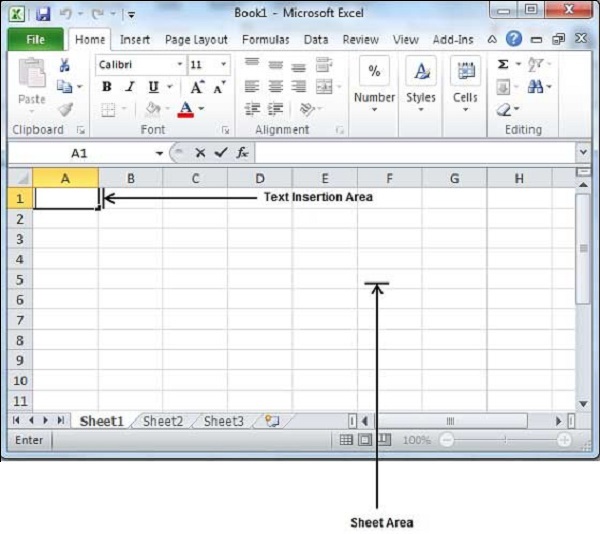
Sheet area is the place where you type your text. The flashing vertical bar is called the insertion point and it represents the location where text will appear when you type. When you click on a box then the box is highlighted. When you double click the box, the flashing vertical bar appears and you can start entering your data.
So, just keep your mouse cursor at the text insertion point and start typing whatever text you would like to type. We have typed only two words "Hello Excel" as shown below. The text appears to the left of the insertion point as you type.
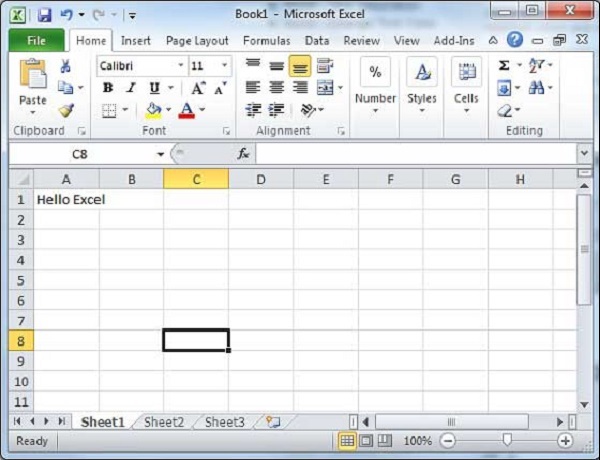
There are following three important points, which would help you while typing −
- Press Tab to go to next column.
- Press Enter to go to next row.
- Press Alt + Enter to enter a new line in the same column.
Move Around in Excel 2010
- Excel provides a number of ways to move around a sheet using the mouse and the keyboard.First of all, let us create some sample text before we proceed. Open a new excel sheet and type any data. We've shown a sample data in the screenshot.
OrderDate Region Rep Item Units Unit Cost Total 1/6/2010 East Jones Pencil 95 1.99 189.05 1/23/2010 Central Kivell Binder 50 19.99 999.5 2/9/2010 Central Jardine Pencil 36 4.99 179.64 2/26/2010 Central Gill Pen 27 19.99 539.73 3/15/2010 West Sorvino Pencil 56 2.99 167.44 4/1/2010 East Jones Binder 60 4.99 299.4 4/18/2010 Central Andrews Pencil 75 1.99 149.25 5/5/2010 Central Jardine Pencil 90 4.99 449.1 5/22/2010 West Thompson Pencil 32 1.99 63.68 6/8/2010 East Jones Binder 60 8.99 539.4 6/25/2010 Central Morgan Pencil 90 4.99 449.1 7/12/2010 East Howard Binder 29 1.99 57.71 7/29/2010 East Parent Binder 81 19.99 1,619.19 8/15/2010 East Jones Pencil 35 4.99 174.65 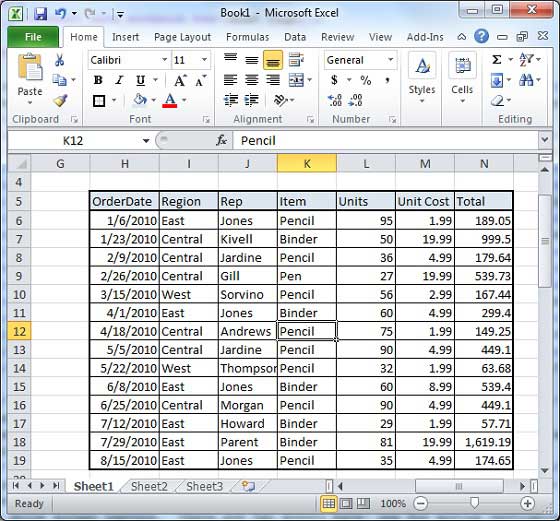
Moving with Mouse
You can easily move the insertion point by clicking in your text anywhere on the screen. Sometime if the sheet is big then you cannot see a place where you want to move. In such situations, you would have to use the scroll bars, as shown in the following screen shot −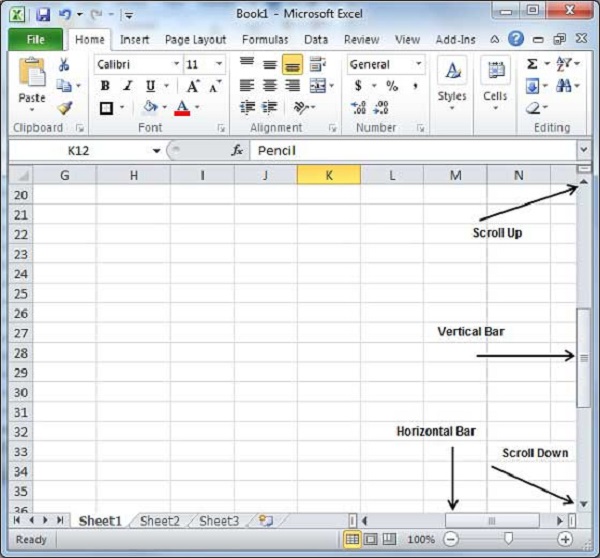
You can scroll your sheet by rolling your mouse wheel, which is equivalent to clicking the up-arrow or down-arrow buttons in the scroll bar.Moving with Scroll Bars
As shown in the above screen capture, there are two scroll bars: one for moving vertically within the sheet, and one for moving horizontally. Using the vertical scroll bar, you may −- Move upward by one line by clicking the upward-pointing scroll arrow.
- Move downward by one line by clicking the downward-pointing scroll arrow.
- Move one next page, using next page button (footnote).
- Move one previous page, using previous page button (footnote).
- Use Browse Object button to move through the sheet, going from one chosen object to the next.
Moving with Keyboard
The following keyboard commands, used for moving around your sheet, also move the insertion point −Keystroke Where the Insertion Point Moves 
Forward one box 
Back one box 
Up one box 
Down one box PageUp To the previous screen PageDown To the next screen Home To the beginning of the current screen End To the end of the current screen You can move box by box or sheet by sheet. Now click in any box containing data in the sheet. You would have to hold down the Ctrl key while pressing an arrow key, which moves the insertion point as described here −Key Combination Where the Insertion Point Moves Ctrl + 
To the last box containing data of the current row. Ctrl + 
To the first box containing data of the current row. Ctrl + 
To the first box containing data of the current column. Ctrl + 
To the last box containing data of the current column. Ctrl + PageUp To the sheet in the left of the current sheet. Ctrl + PageDown To the sheet in the right of the current sheet. Ctrl + Home To the beginning of the sheet. Ctrl + End To the end of the sheet. Moving with Go To Command
Press F5 key to use Go To command, which will display a dialogue box where you will find various options to reach to a particular box.Normally, we use row and column number, for example K5 and finally press Go To button.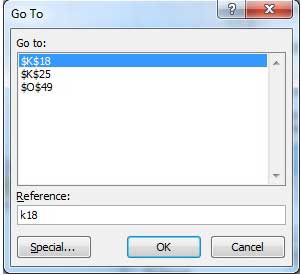
Save Workbook in Excel 2010
Saving New Sheet
Once you are done with typing in your new excel sheet, it is time to save your sheet/workbook to avoid losing work you have done on an Excel sheet. Following are the steps to save an edited excel sheet −Step 1 − Click the File tab and select Save As option.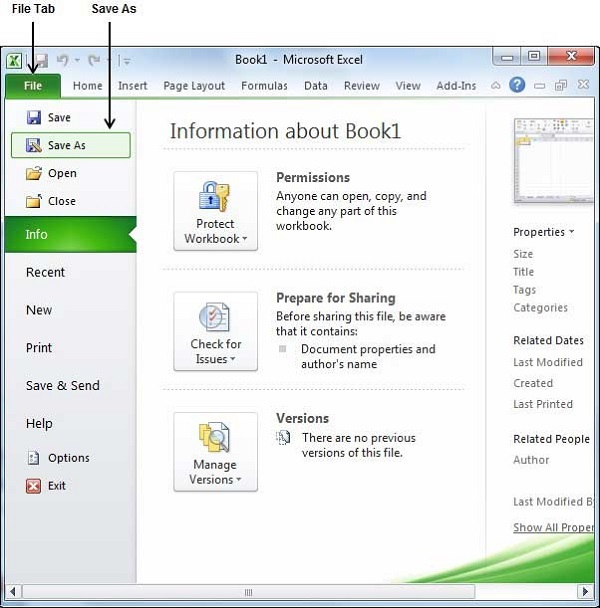
Step 2 − Select a folder where you would like to save the sheet, Enter file name, which you want to give to your sheet and Select a Save as type, by default it is .xlsx format.
Step 3 − Finally, click on Save button and your sheet will be saved with the entered name in the selected folder.Saving New Changes
There may be a situation when you open an existing sheet and edit it partially or completely, or even you would like to save the changes in between editing of the sheet. If you want to save this sheet with the same name, then you can use either of the following simple options −- Just press Ctrl + S keys to save the changes.
- Optionally, you can click on the floppy icon available at the top left corner and just above the File tab. This option will also save the changes.
- You can also use third method to save the changes, which is the Save option available just above the Save As option as shown in the above screen capture.
If your sheet is new and it was never saved so far, then with either of the three options, word would display you a dialogue box to let you select a folder, and enter sheet name as explained in case of saving new sheet.Create Worksheet in Excel 2010
Creating New Worksheet
Three new blank sheets always open when you start Microsoft Excel. Below steps explain you how to create a new worksheet if you want to start another new worksheet while you are working on a worksheet, or you closed an already opened worksheet and want to start a new worksheet.Step 1 − Right Click the Sheet Name and select Insert option.
Step 2 − Now you'll see the Insert dialog with select Worksheet option as selected from the general tab. Click the Ok button.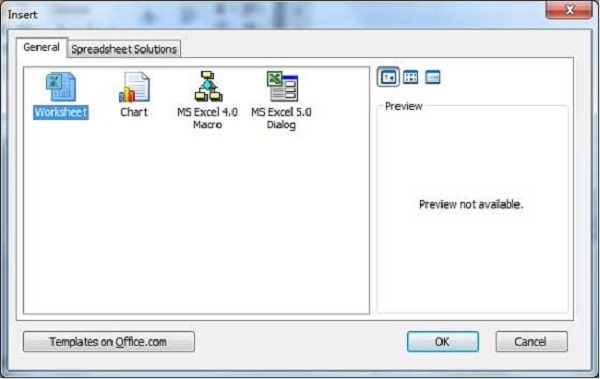
Now you should have your blank sheet as shown below ready to start typing your text.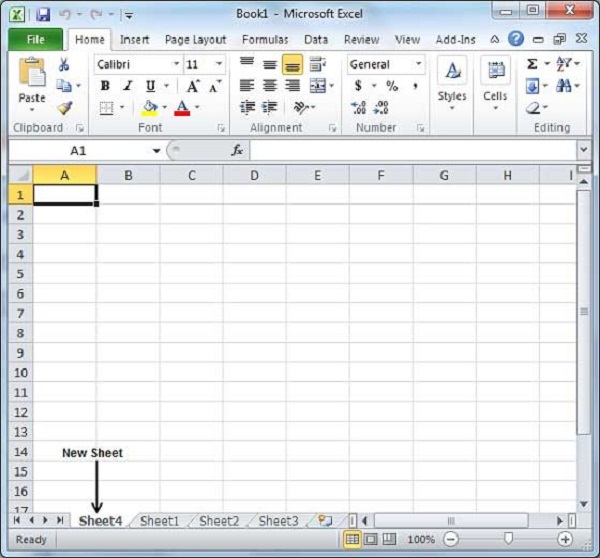
You can use a short cut to create a blank sheet anytime. Try using the Shift+F11 keys and you will see a new blank sheet similar to the above sheet is opened.Copy Worksheet in Excel 2010
Copy Worksheet
First of all, let us create some sample text before we proceed. Open a new excel sheet and type any data. We've shown a sample data in the screenshot.OrderDate Region Rep Item Units Unit Cost Total 1/6/2010 East Jones Pencil 95 1.99 189.05 1/23/2010 Central Kivell Binder 50 19.99 999.5 2/9/2010 Central Jardine Pencil 36 4.99 179.64 2/26/2010 Central Gill Pen 27 19.99 539.73 3/15/2010 West Sorvino Pencil 56 2.99 167.44 4/1/2010 East Jones Binder 60 4.99 299.4 4/18/2010 Central Andrews Pencil 75 1.99 149.25 5/5/2010 Central Jardine Pencil 90 4.99 449.1 5/22/2010 West Thompson Pencil 32 1.99 63.68 6/8/2010 East Jones Binder 60 8.99 539.4 6/25/2010 Central Morgan Pencil 90 4.99 449.1 7/12/2010 East Howard Binder 29 1.99 57.71 7/29/2010 East Parent Binder 81 19.99 1,619.19 8/15/2010 East Jones Pencil 35 4.99 174.65 
Here are the steps to copy an entire worksheet.Step 1 − Right Click the Sheet Name and select the Move or Copy option.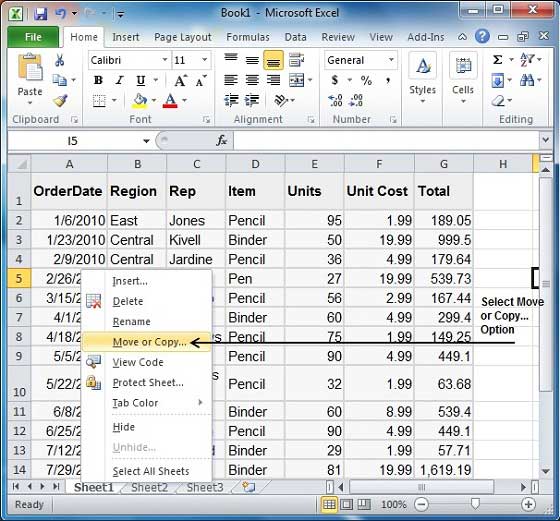
Step 2 − Now you'll see the Move or Copy dialog with select Worksheet option as selected from the general tab. Click the Ok button.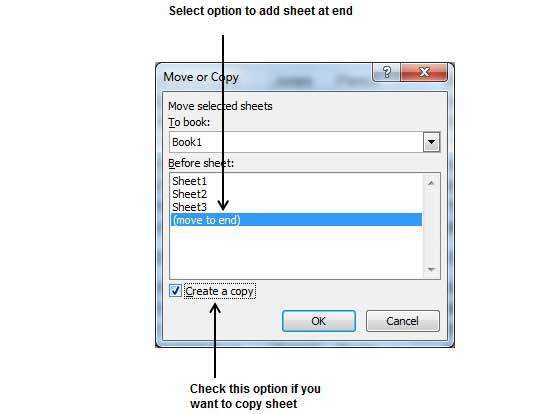
Select Create a Copy Checkbox to create a copy of the current sheet and Before sheet option as (move to end) so that new sheet gets created at the end.Press the Ok Button.Now you should have your copied sheet as shown below.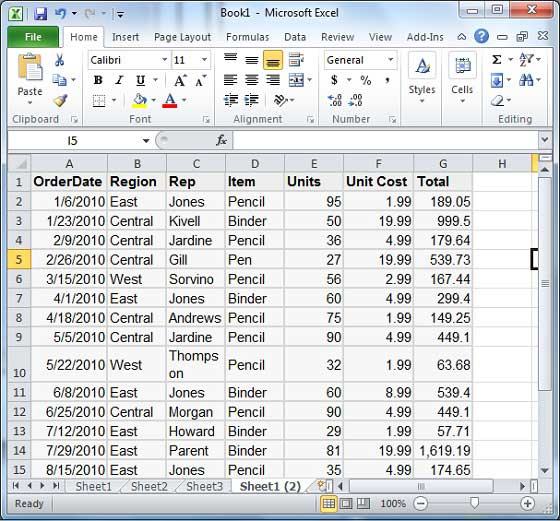
You can rename the sheet by double clicking on it. On double click, the sheet name becomes editable. Enter any name say Sheet5 and press Tab or Enter Key.Hiding Worksheet in Excel 2010
Hiding Worksheet
Here is the step to hide a worksheet.Step − Right Click the Sheet Name and select the Hide option. Sheet will get hidden.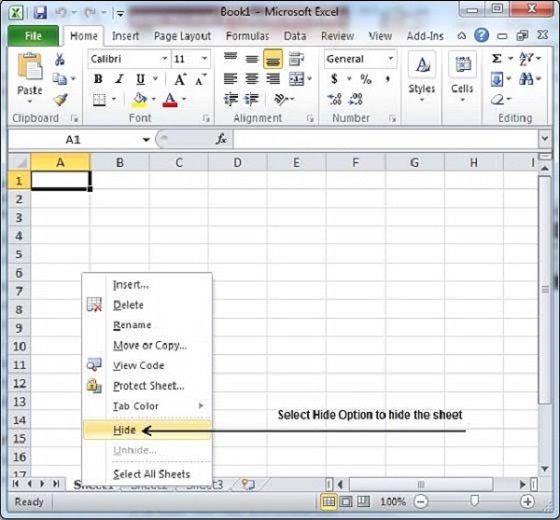
Unhiding Worksheet
Here are the steps to unhide a worksheet.Step 1 − Right Click on any Sheet Name and select the Unhide... option.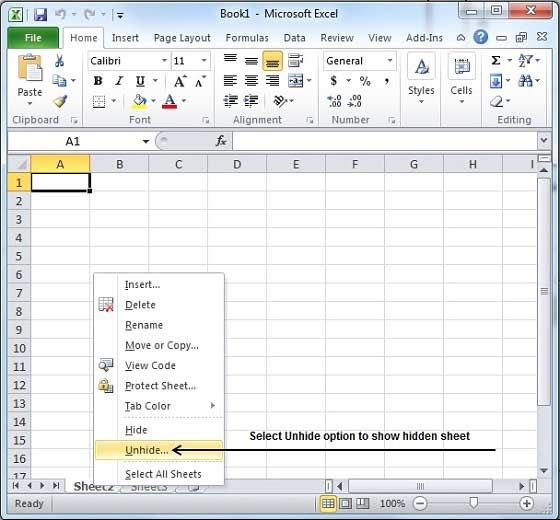
Step 2 − Select Sheet Name to unhide in Unhide dialog to unhide the sheet.Press the Ok Button.Now you will have your hidden sheet back.Delete Worksheet in Excel 2010
Delete Worksheet
Here is the step to delete a worksheet.Step − Right Click the Sheet Name and select the Delete option.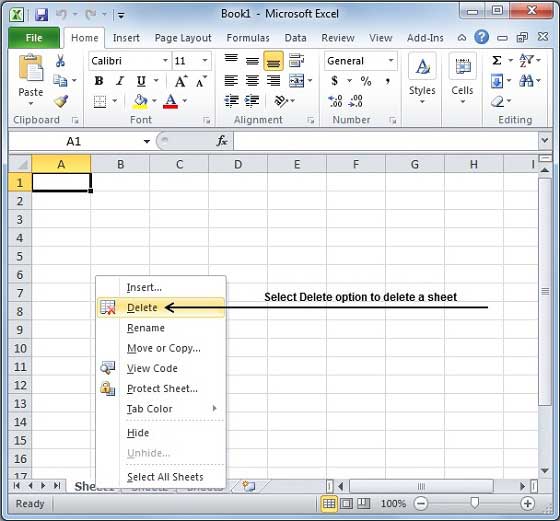
The sheet will get deleted if it is empty, otherwise, you'll see a confirmation message.
Press the Delete Button.Now your worksheet will get deleted.Close Workbook in Excel 2010
Close Workbook
Here are the steps to close a workbook.Step 1 − Click the Close Button as shown below.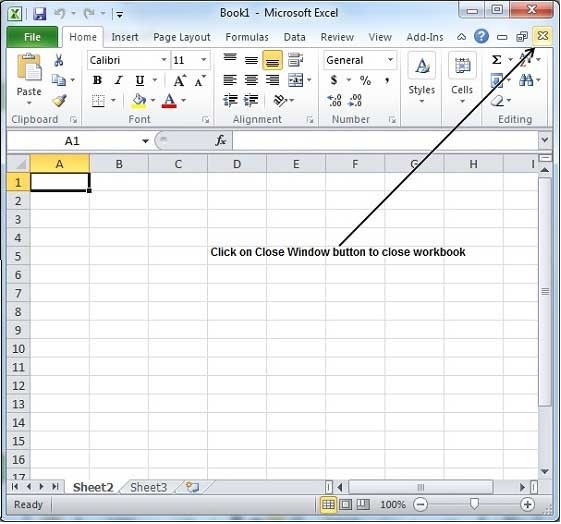
You'll see a confirmation message to save the workbook.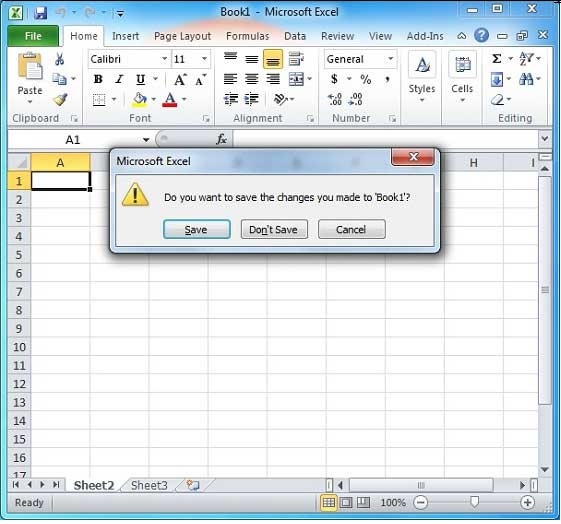
Now your worksheet will get closed.Open Workbook in Excel 2010
- Let us see how to open the workbook from excel in the below-mentioned steps.Step 1 − Click the File Menu as shown below. You can see the Open option in File Menu.There are two more columns Recent workbooks and Recent places, where you can see the recently opened workbooks and the recent places from where workbooks are opened.
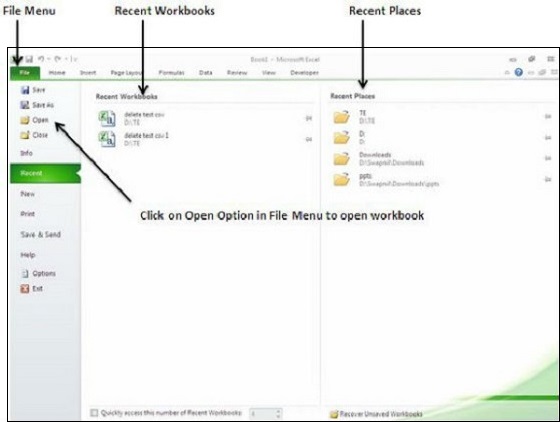
Step 2 − Clicking the Open Option will open the browse dialog as shown below. Browse the directory and find the file you need to open.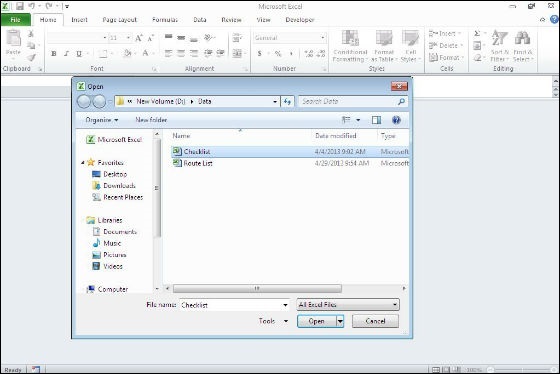
Step 3 − Once you select the workbook your workbook will be opened as below −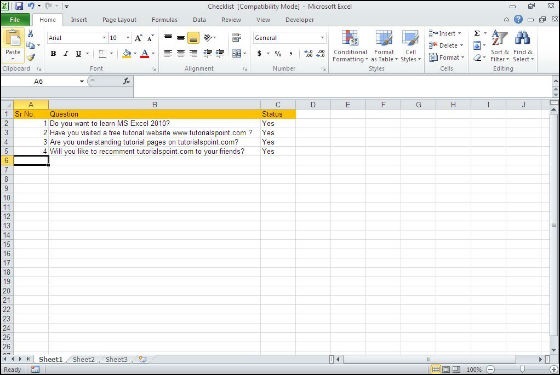
Context Help in Excel 2010
- MS Excel provides context-sensitive help on mouseover. To see context-sensitive help for a particular Menu option, hover the mouse over the option for some time. Then you can see the context-sensitive Help as shown below.
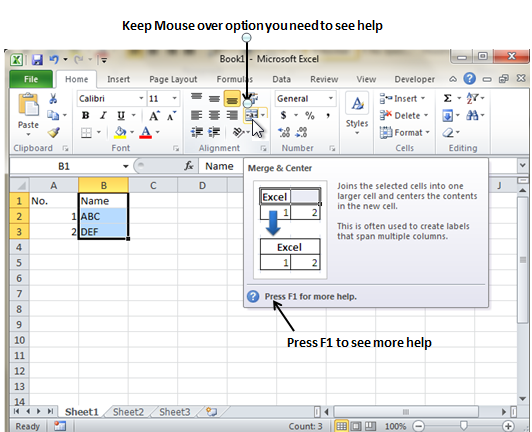
Getting More Help
For getting more help with MS Excel from Microsoft you can press F1 or by File → Help → Support → Microsoft Office Help.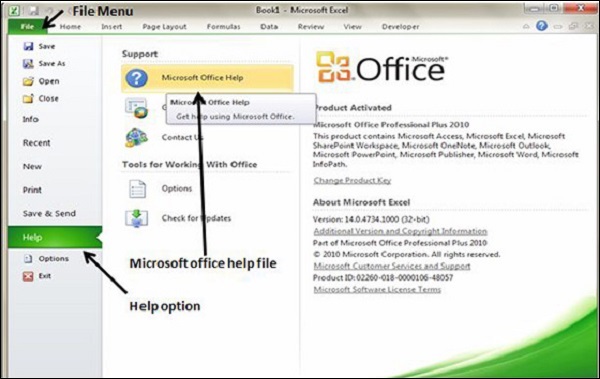







0 Comments